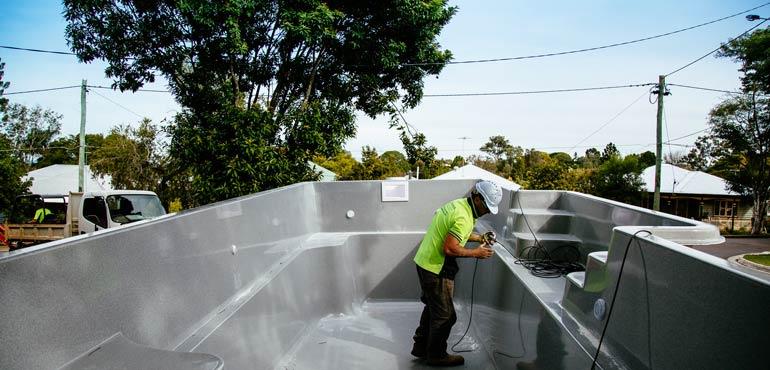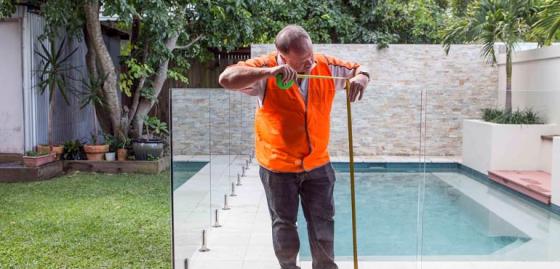
- Home
- Your property
- Swimming pools
- Build a pool
Build a pool
A swimming pool can be a great addition to your home. However, you need to follow the state government's safety standard when building and maintaining your pool to keep children safe.
Plan your pool
Talk to family and friends who own pools about:
- size
- location
- finishes
- landscaping
- building time
- upkeep
- construction issues.
Follow safety guidelines
Consider the requirements of the swimming pool safety standard when positioning your pool on the block, and while planning your pool fence and landscaping.
Consider safety aspects when planning:
- location and type of pool fence
- changes needed to neighbouring fences
- location of pump or filter (must not be placed where children could climb them to gain access to the pool)
- location of pool to ensure no direct access from doors and windows
- location of pool in relation to trees, decks, balconies and stairs
Note the pool safety rules include specific guidelines for structures built within the pool enclosure.
Follow our pool safety guidelines to make sure your pool complies.
Plan for safety throughout build
You need to make sure you follow the pool safety standard throughout the process of building your pool. You should:
- plan the correct safety features
- use the correct signs and fences during construction
- check and maintain your child-safe fences and gates once the pool has water in it.
Choose a pool builder
Arrange several pool builders to:
- inspect your site
- provide a written quote
- give you details of their warranties.
Before you accept a quote or sign a contract check the pool builder's licence and licence history.
What the quote should cover
Discuss with the pool builders what you want your pool to look like and what it should feature, including:
- shape
- location on site
- interior lining
- size
- depth
- number and type of inlets, skimmer boxes and drains
- filtration equipment type, capacity and position
- accessories such as underwater lights, cleaners, ladders and handrails
- does the quote include fencing?.
Confirm exactly what work will be included in the price, and whether it will also include elements such as pool surrounds and landscaping.
Your quote should also include the premium for insurance through the Queensland Home Warranty Scheme, which is compulsory for all domestic building projects valued at more than $3,300.
What the contract should cover
If you're doing domestic building work over $3,300 you need a contract. Your builder could use one of the custom pool contracts provided by the Swimming Pool and Spa Association (SPASA).
Your contractor must provide you with:
- a 5-business day 'cooling-off' period
- a written contract
- a QBCC-approved Contract Information Statement.
The deposit must not be:
- more than 10% for work up to $20,000 in value
- 5% for projects $20,000 or more.
The deposit amount usually includes the premium for insurance through the Queensland Home Warranty Scheme, which the contractor collects from you and pays to the QBCC on your behalf.
Read your contract carefully and seek legal advice about any concerns before signing.
Your contract should include:
- appropriate drawings
- details of all aspects of your pool, including:
- physical dimensions
- shape
- size
- water depth
- interior finish
- type of filtration
- access
- the amount and timing of progress payments
- provisions for unforeseen events (e.g. finding rock during excavation or wet weather)
- warranties on the pool and the associated equipment.
Get approvals
Before building a pool you must get building approvals from your local council or private certifier. In most cases your pool builder will arrange this.
You, or your builder, must:
- obtain architectural plans and engineering specifications
- engage a private certifier (who lodges the documents with your local council) or a certifier through your local council.
Your certifier will let you know:
- if you need to engage an engineer to do a structural report (if you are building on a difficult site)
- if you need any additional approvals, e.g. if you need to build over a sewer line or if you need town planning approval to build in a special zone.
Insure your pool
If you have an insurance policy covering your house and contents, check your new pool will be covered. You may have to increase your coverage or arrange an extension to your existing house and contents policy.
Your pool builder must take out insurance through the Queensland Home Warranty Scheme. This provides home owners with cover for loss where the licensed contractor does not complete the contracted works or fails to rectify defective work.
Erect a warning sign
If you are building a swimming pool, you must put up a warning sign before starting construction.
The warning sign must:
- warn a swimming pool is under construction
- warn there is a danger to young children accessing the land (e.g. 'Danger. Swimming pool under construction. Keep children out.')
- be placed within 1.5m of the road frontage for the land
- be positioned so that it is visible from the road
- be mounted so that the bottom of the sign is at least 300mm above ground level
- be made of weatherproof material
- be written in bold text at least 50mm high.
A warning sign is only required on one of the road frontages.
Build a pool fence
You have several options for building a pool fence. All fences must comply with the swimming pool barriers standard.
Read more about how to build a fence that complies with the safety standard.
Temporary fencing
Pools under construction don't need to comply with the pool safety standard until the pool is about to be filled to a depth of 300mm or more.
It may be appropriate to construct a temporary fence for workplace health and safety reasons during construction while the pool is empty.
You must have a compliant fence before you fill the pool with 300mm or more of water. A temporary fence may be relied upon instead of a permanent fence for a period of up to 3 months only if it has been inspected and approved by the building certifier who approved your pool application.
The certifier should issue a Form 16—inspection certificate/aspect certificate/QBCC licensee aspect certificate (PDF).
A temporary fence can only be used for longer than 3 months if your building certifier provides further written approval.
You must build a permanent compliant fence before the certifier can give the final inspection certificate.
Get a final inspection to certify your pool
The building certifier who approved your pool building approval must inspect and certify the pool fence before the pool is filled to a depth of 300mm or more. If approved the certifier must issue either a:
- Form 17—final inspection certificate for pools and barriers (PDF)
- Form 11—certificate of occupancy for a building with a regulated pool (PDF).
The certifier must provide a copy of the Form 17 or Form 11 to the QBCC.
Arrange a handover
Once the pool is built your pool builder must give you a comprehensive handover. They need to teach everyone who will care for and maintain your pool how to:
- sanitise the water
- operate and maintain the filtration equipment
- operate and maintain the chlorination equipment (if applicable).
Register your pool
Follow the instructions to register your pool.
